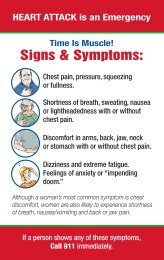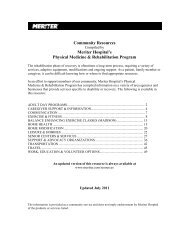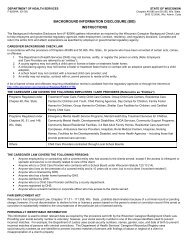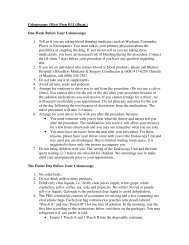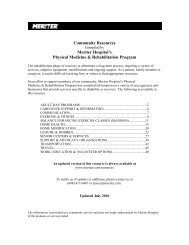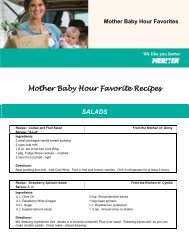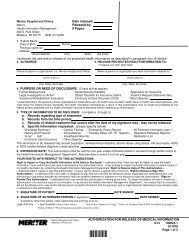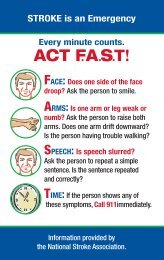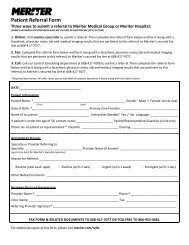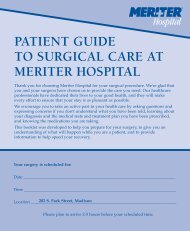A Guide To Your New Family's First Weeks - Meriter Health Services
A Guide To Your New Family's First Weeks - Meriter Health Services
A Guide To Your New Family's First Weeks - Meriter Health Services
You also want an ePaper? Increase the reach of your titles
YUMPU automatically turns print PDFs into web optimized ePapers that Google loves.
Recognizing Illness<br />
Illness in a newborn can be a serious and life-threatening event. It is important to recognize the early signs of<br />
illness (see the inside cover for signs) and report these to your doctor.<br />
Taking Temperatures<br />
Ask your nurse to demonstrate how to take your<br />
baby’s temperature, both rectally and under the arm.<br />
Practice each method before you go home with your<br />
baby.<br />
Types of Thermometers<br />
You will go home with a digital thermometer.<br />
Digital thermometers are inexpensive and accurate.<br />
Ear thermometers may be expensive and difficult<br />
to use. They are not recommended for infants.<br />
Fever strips placed on the forehead and pacifier<br />
thermometers are not accurate and are not<br />
recommended.<br />
How to Take a Baby’s Temperature<br />
<strong>To</strong> take an underarm temperature, turn the<br />
thermometer on, slip the thermometer underneath<br />
your baby’s clothes and place the bulb end in your<br />
baby’s armpit (skin to skin). Hold your baby’s arm<br />
down over it. Wait for the thermometer to beep.<br />
<strong>Your</strong> doctor may ask you to take a rectal temperature<br />
if your baby is ill. Lubricate the end with a petroleum<br />
jelly product. Place a diaper under your baby’s<br />
bottom. Lay your baby on his tummy. Use your free<br />
hand to hold and gently separate your baby’s bottom<br />
while inserting just the silver tip of the thermometer<br />
into the rectum. Once inserted, hold your baby and<br />
thermometer securely. Use a plastic thermometer<br />
sleeve or wash thoroughly when finished. Nursing<br />
staff will demonstrate temperature taking before you<br />
go home. An underarm temperature is slightly lower<br />
than a rectal temperature.<br />
When to Take a Baby’s Temperature<br />
If your baby seems uncomfortable and warm, do not<br />
rely on touch; take your baby’s temperature.<br />
Normal temperatures ranges:<br />
Rectal: 97.9° to 100.4° F (36.6° to 38° C)<br />
Axillary (under arm): 97.5° to 99.1° F (36.4°<br />
to 37.3° C)<br />
You should report a rectal temperature greater<br />
than 100.4° F during your baby’s first two<br />
months. A low temperature may also be a sign<br />
of illness; report a temperature less than 97°F.<br />
Using A Bulb Syringe<br />
We suggest you keep a bulb syringe handy in your<br />
home, and bring it with you when you leave your<br />
house with your baby. You may use a bulb syringe<br />
to clean your baby’s nose and mouth of formula or<br />
mucus on occasions when your baby spits up, has a<br />
stuffy nose or sneezes. (Babies sneeze to try to clear<br />
their noses.)<br />
<strong>To</strong> use a syringe:<br />
• <strong>First</strong>, squeeze the bulb until you collapse it.<br />
• Place it in one nostril and quickly release the bulb.<br />
This will bring the spit-up or mucus into the bulb.<br />
• Remove the bulb syringe from the nose and<br />
squeeze the bulb quickly into a tissue to get rid of<br />
collected material. Repeat for the other nostril and<br />
mouth, if necessary.<br />
<strong>To</strong> clean a syringe:<br />
• Each day you use the bulb syringe, clean it with<br />
hot soapy water.<br />
• Rinse in hot water.<br />
• Be sure to clean the inside of the bulb by<br />
squeezing the bulb while the tip is in the soapy<br />
water.<br />
• Rinse by repeating the procedure with clean hot<br />
water.<br />
• Discard after any illness and use a new syringe.<br />
45



